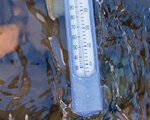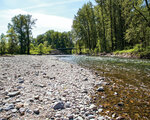

The temperatures are hot as a heatwave has arrived in the region, but Clark County’s rivers will remain well below comfortable temperatures.
At Daybreak Regional Park on Thursday, May 11, the East Fork Lewis River at just ankle depth registered around 55 degrees Fahrenheit while the outside air temperature came in around 77 degrees Fahrenheit.
“Cold shock can be just as severe and dangerous from water temperatures of 50-60F (10-15C) as it is from water at 35F (2C). Gasping for a breath or rapid breathing from sudden immersion can be triggered by water as warm as 77F (25C),” the National Weather Service states.
Not only are the cold temperatures a concern for utilizing area rivers, but high flows from snow melt are still occurring. That can make river currents swift and difficult to manage for swimmers of all experience levels. Rivers also have a lot of submerged, unseen water hazards. The National Park Service asks swimmers of all experience levels to understand that strong currents can pull a swimmer under the water, which can lead to cold water shock.
“In as little as six inches of water, there can be currents strong enough to knock you off your feet and sweep you downstream,” the National Park Service stated in a release.
Locally, Maddie Pearl, of the Clark-Cowlitz Fire Rescue Community Risk Reduction Division, confirmed there have been five water rescues this year in their fire district with three occurring in April.
“We always expect that number to rise as more people come out to recreate in or near the water as the weather starts to get warmer,” Pearl stated in an email.
Pearl added in an interview that swimmers are encouraged to use a United States Coast Guard approved life jacket that is appropriately rated for one’s weight.
“Oftentimes in cold water shock we see your muscles start to tense up. You have a lot less endurance, and you can have some respiratory spasming where it makes it feel hard to breathe,” Pearl said. “Especially in these spring seasons, it doesn’t take long for you to start to feel hypothermic in these cold waters.”
Washington State Rep. Peter Abbarno’s “Zack’s Law” recently passed the Legislature unanimously. The legislation is designed to raise awareness about cold water shock deaths and is named after 18-year-old Zachary Lee Rager, who was an experienced swimmer. Rager drowned in the Chehalis River after he jumped from a Willapa Hills Trail railroad trestle bridge. He experienced cold water shock, a physical response to the sudden immersion in cold water that includes increased heart rate, faster breathing and potentially uncontrolled gasping and movement.
Zack’s Law aims to prevent cold water shock drownings by requiring state government agencies and local governments to erect signs warning of drowning hazards when they replace or erect signs near dangerous water hazards.
The signs will be erected at the same time upgrades are made to bridges and other water-adjacent infrastructure, so there will not be a significant cost to taxpayers, according to a Washington State House Republicans news release.
The bill also creates a mechanism for the public to donate funds to the state for the specific purpose of erecting signs in locations known to attract people to what could be hazardous waterways.
•••
Previous reporting by The Reflector was included in this report.